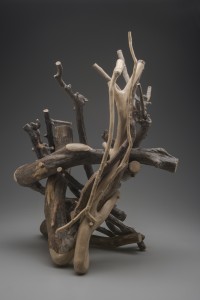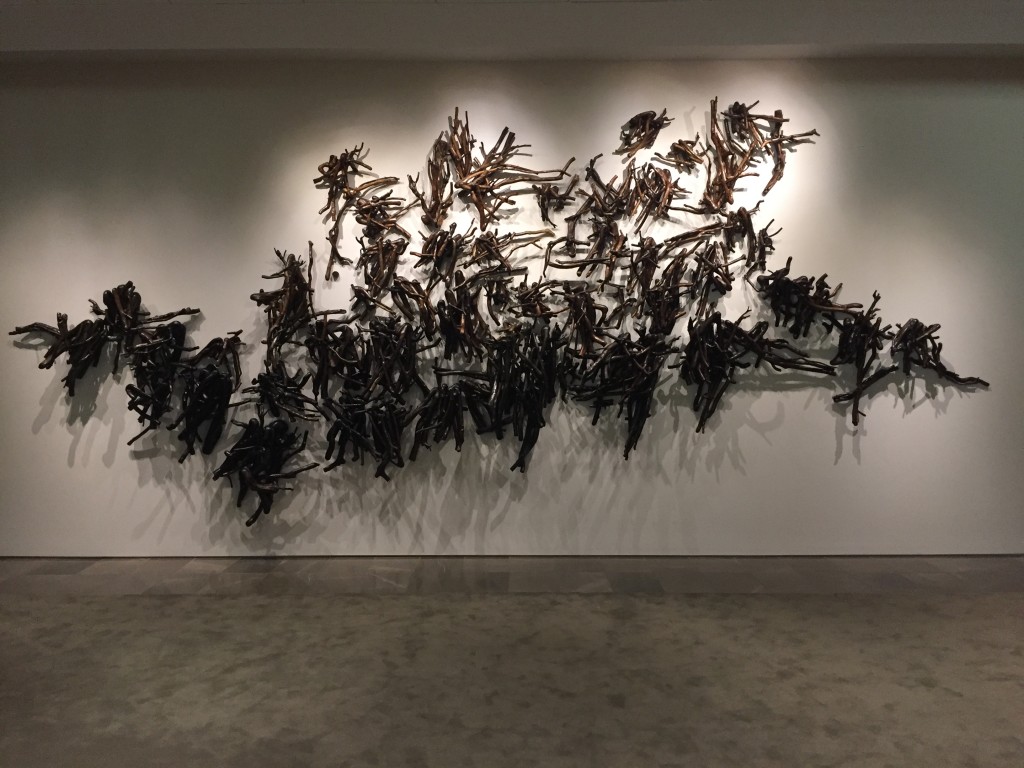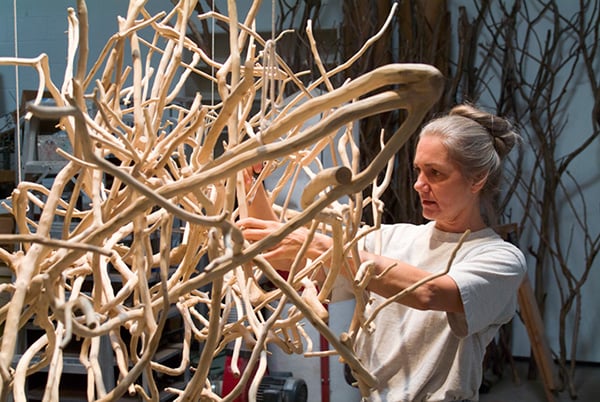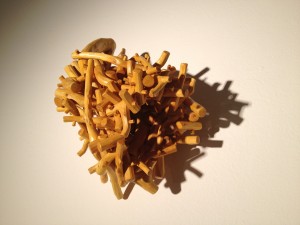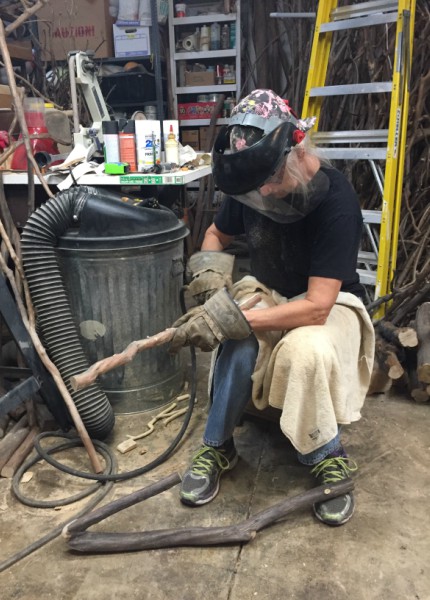A Natural Sculptor
ArtandSeek.net December 14, 2017 45Welcome to the Art&Seek Artist Spotlight. Every Thursday, here and on KERA FM, we’ll explore the personal journey of a different North Texas creative. As it grows, this site, artandseek.org/spotlight, will eventually paint a collective portrait of our artistic community. Check out all the artists we’ve profiled.
Growing up, Dallas artist Sherry Owens spent summers in Houston, surrounded by Crape Myrtle. She loved the shape and the flowers of Texas’ favorite shrub. Now, decades later, the branches are the building blocks for her sculptures. In this week’s Art&Seek Artist Spotlight, reporter I learn that those branches have also become an obsession.
“Okay c’mon in,” Owens hollers toward me as she leads me down a hallway made of chopped down tree limbs. “Now watch your face, because these sticks can just come out and grab you.”
Owens is showing me around her studio. It’s gigantic – and it’s littered with thousands of Crape Myrtle tree limbs.
“There are literally branches everywhere,” I say to Owens with astonishment.
“Well, I know,” Owens says to me with a satisfied smirk on her face.
Walking through the studio is like walking through the woods, but the trees have no leaves. The limbs are stacked about six feet high, forming paths and lining every wall. They’re also filling garbage cans and metal shelving. And above us, there are even more stored in the rafters.
“This time yesterday, you couldn’t have even walked in here,” Owens says. “I have really cleaned up.”
Owens says there’s even more in a storage container outside, “those those two steel containers,” says Owens. “Well one is just a storage [for more limbs]. They’re both 20 feet long, eight feet high, eight feet wide.”
For about 15 years now, Owens has been growing her own strange, fairy-tale forest here inside her stuio.
“People will call me and they’ll say, ‘Sherry, I’ve got a couple of Crape Myrtle trees that I want to take down. Do you want’em?’ And I’m like, ‘Sure!’”
She works in the middle of this forest. It’s the only space left for her tools and work benches.
“You see all these little tiny knives?” Owens asks. “People are like, ‘You carve all of this [laughs] with little tiny knives?’ And I’m like, ‘Well, yea! But first I used a die grinder.’”
Her sculptures are maze-like structures, sometimes the color of bones. She strips the limbs of their bark, often dyes them, and then weaves them into forms that look like waves or giant bird’s nests.
Every piece is unique. They can take years to make. She spends hours sifting through her collection, looking for just the right stick. And there are hundreds of sticks in every piece.
“So I try to be really open to the material,” explains Owens. “I try to let that material speak to me. Cause I don’t want to force it. I really want the lines to work together and to represent that idea.”
Owens was born in East Texas but raised in Irving. Childhood summers at her grandfather’s ranch near Houston opened her to nature and art.
“Yea! And I used to sew a lot,” says Owens. “I’d make all of my clothes. And you know, I’ve always made things with my hands.”
At first, the SMU graduate was interested in weaving. She dyed yarn unique colors and created massive pieces. Then she started welding. But the physical demands were too much.
“The doctor said, ‘You better stop your wicked ways,’” recalls Owens. “[Laughs] ‘You mean I can’t weld anymore? What’s with that?’” she jokes.
About 25 years ago, Owens returned to weaving. But this time, she got the idea to use crape myrtle instead of wool.
“She’s taking raw nature and she’s making it literally twist in space,” says Shirley Reece-Hughes.
Reece-Hughes is a curator at the Amon Carter Museum of American Art. She says there are three things that set Owens apart from other Texas sculptors: her unique materials, her craftsman ship and her ability to tell stories through her work.
“I really think she’s being recognized right now for what she’s contributing to this narrative of sculpture, particularly in Texas,” says Reece-Hughes.
That’s why Reece-Hughes selected the sculpture “Dust Devil” to be part of the exhibition Commanding Space: Women Sculptors of Texas.” The piece looks like a tornado from a distance, but up close the perspective changes.
“Thinking about a sculpture where you’ve got a work of art that you see and you can look inside and almost a different work of art,” Reece-Hughes explains, “that’s a testament to her vision.”
The Amon Carter is one of five museums exhibiting Owens’ work this year. Owens is happy that folks appreciate her craftsmanship. But she also hopes they’re getting a deeper message.
“I hope my work asks a lot of questions, especially about the environment, because we’re really screwing up,” says Owens.
Owens likes to call herself a recycle artist. She’s making art with material people discard. At age 67, she’s got a lot more work planned… All she needs is to find is exactly the right piece of crape myrtle.
Where did your interest in art come from?
My interests in art came from a couple places. One – being an only child and making mud pies when I was little. I’d play outside all day when I was little. Also, during the summers when I was growing up, my momma worked and she had to do something with me, so she sent me to day camp at the YMCA in downtown Dallas. My favorite part of camp was art, it was making things. And the first sculpture I ever made was made from an Ivory bar. I made a horse’s head and painted it black.
So creating was just sort of innate for you as a child?
Yea. I used to sew a lot back then too. I’d make all of my clothes and I’d make doll clothes. Yea, I’ve always been a maker. You know, I’ve always made things with my hands.
But it was other things too. Like even making cards or whatever. You know? Kids make all sorts of things, but I guess I would just go a little overboard (laughs).
You’ve been working with crepe myrtle for nearly 30 years. But you started with weaving and macramé. You’ve welded metal sculptures. How did you decide that this was the material and medium that you wanted to create in?
Well, I’m not done creating with crepe myrtle. There’s a lot of ways to use the sticks and the lines that I just haven’t explored yet. I mean, it takes so long to make the work. You know, I have sketchbooks full of ideas.
When I make a piece, it’s always about something. And it may be something about the environment or it may be something I’ve observed and I’m just making a comment on it.
I have sketchbooks that go back for forever. I always tell students that you need to keep a sketchbook. You can write your grocery list in there. I don’t care. It doesn’t matter. But you just need to write your thoughts down and do sketches and just keep it going. And don’t show it to anyone. It’s yours. It’s almost like a diary, you know? It’s part of the process. And the process is really important to me.
That’s a big take away from my tour of your studio. You’re all about the process. You’re finding these trees, drying them out, freezing them to remove insects, trimming small branches, removing the bark. . . This is all prior to construction!
Right! That’s actually the reason that so many of these branches (inside my studio) are so big. See, I don’t want to go ahead and just start cutting these branches up at different places on the limb, because I don’t know how I want to use this yet. Do you know what I mean?
I’ll cut these branches off people’s tree (avoiding crepe murder) and I cut them into a size I can actually manage. But when the limb has branches that are going every which way – that’s great! I may end up cutting a branch off and creating an “elbow” or I may end up cutting a limb and using a couple of twisted branches in one piece.
So I really try to look at the line of the wood. I really try to make it speak in the work.
Well, considering the way that you work, does that mean when you’re attempting to create something that you’ve sketched that you’re hunting for the right branch? Or are you simply making the pieces you need? Manipulating the wood?
Yes. I am search for the stick. I search for that curve. I mean sometimes I can make a curve out of multiple sticks. I sort of bundle sticks in a way to cause your eye to travel down a certain line.
You know, people are always asking me, ‘How can you draw this? How do you know how to make a turn or a curve? How can you see this?’ And well, it’s because I’ve just worked with this wood so long and I’m sort of in tune with it. I just know how it grows, so I just draw it and then I go look and see what I’ve got.
You’ve been a professional artist in North Texas for more than three decades. What’s it like as a sculptor?
Well, people have always said, ‘sculptures the thing in the way of you looking at the painting.’ You know? (laughs) It’s hard to sell sculpture. It’s big. It takes up space. And people like 2-dimensional things that they can put on their wall and look at. But sculpture? That’s a whole different animal. You have to walk around it. You have to have a place for it. That’s why I make so many different styles of work. Sometimes they’re suspended from the ceiling or tiny or they’re on the wall or they sit on tables or it’s giant and it comes up from the floor… I don’t some people appreciate sculpture.
And I’ll tell you that the Nasher Sculpture Center has done a lot for Dallas. That could have gone anywhere. People all over the world wanted that collection. But Raymond D. Nasher was just so generous and said, ‘I think I’m just going to put it here in Dallas.’ We’re so lucky. That’s such a gem. Plus, that whole area with the DMA and Crow Collection is just a wonderful little hub.
And don’t get me started on Fort Worth. I just feel really fortunate to be here. I don’t want to live anywhere else. This is just a great place to be. There’s always things to go look at.
Are you creatively satisfied?
Yea I am! You know I am always asked, ‘What’s your favorite piece?’ And I always say, ‘Well, what’s the last piece I did?’ That’s because that last piece I did is always my favorite. But there are more things that I want to do. I just haven’t done them yet.
These sculptures take a lot of work. Do you think people know about how laborious they are to make?
Well, I hope people know that I work really intuitively with the branches and shape. But I don’t really work conventionally. I work at night. I start around 5 pm. That’s when I get going. Sometimes, I go until 2:00 or 3:00 in the morning. Sometimes I look up and there’s sun coming in through the windows and I look at the clock and it’s 6 am. And I think to myself, ‘Oh! That’s why my shoulders are hurting.’
And you saw I am hunched over gripping the branches while the die grinder is removing bark. And I can only use that grinder in intervals of one-and-a-half to two hours. Then I have to take a break. I put ice packs on my arms and I do different exercises. Then, after all of that, I can go back to work. But it’s for a shorter and shorter amount of time each break.
So when I’m carving, I can’t just carve for 10 hours straight. It’s just too abusive on my body. So I have to get up and walk around.
I’ve had my knee replaces and vertebrae fused together and I believe it’s all related. Because of the kneeling and lifting and the work it takes. I’ve had a doctor tell me, “You better stop your wicked ways!” (laughs) But when you’re on deadline or in a groove, the adrenaline and excitement keeps you going.
When did you begin to call yourself an artist?
When? I don’t know? I went to art school. I was an education major when I went to school. But you had to take an art class and when I did I loved it. So I changed majors. I studied art education. But I was making so much art people thought I was a studio artist, because I spent so much time at the campus studio. I just loved it. Now it’s what I am.
What makes you different from other sculptors?
I have a lot in common with other sculptors. A lot of sculptors are very process driven. And that’s because it can take a lot longer than work that is 2-D. Also, there are a lot of us who are very physical. It’s a very physical work. In sculpture, you are moving around.
Sculpture is also very social. When sculptors get together, we know how to party! Sometimes when painters get together, they’re just sitting around philosophizing. Sculptors are really fun! And we hang out and then we try to help each other. I’ve had to call one or two other sculptors to come over to my place to help me move something or fix something. We just socialize.
Interview questions and answers have been edited for brevity and clarity.


